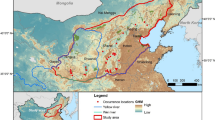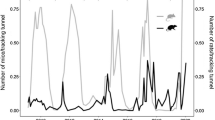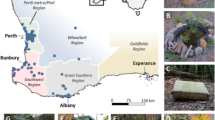Abstract
Environmental heterogeneity contributes to various habitats and may influence the diversity and activity patterns of wildlife among habitats. We used camera traps to assess wildlife habitat use in Guanyinshan Nature Reserve from 2009 to 2012. We focused on four types of habitat including open areas with gentle slope (<15°) (Type1), low elevation areas (about 1500–1700 m) with high bamboo coverage (Type2), high elevation areas (about 2100–2300 m) with high canopy coverage (Type3), and wildlife migration passages (Type4). We analyzed the differences in species richness, relative abundance index (RAI), species diversity, and animals’ activity pattern among habitats. Total six species were analyzed on activity pattern, which are Takin (Budorcas taxicolor), tufted deer (Elaphodus cephalophus), Himalayan goral (Naemorhedus goral), wild boar (Sus scrofa), golden pheasant (Chrysolophus pictus), and porcupine (Hystrix hodgsoni). The results are (1) that there were significant differences in richness and RAIt among habitats; (2) Type4 habitat had the highest richness and RAIt while Type2 had the highest species diversity; giant pandas were found in these two habitats; (3) there were significant differences in species’ activity during daytime and nighttime; and (4) differences appeared in habitat preference of the most abundant species. Takin and tufted deer preferred Type1, Himalayan goral preferred Type2, and golden pheasant preferred Type3. Type4 habitat was used by most animals. All these revealed that habitat heterogeneity plays an important role in species diversity and the importance for conservation.







Similar content being viewed by others
References
Ahumada JA, Silva CEF, Gajapersad K, Hallam C, Hurtado J, Martin E, McWilliam A, Mugerwa B, O’Brien T, Rovero F, Sheil D, Spironello WR, Winarni N, Andelman SJ (2011) Community structure and diversity of tropical forest mammals: data from a global camera trap network. Phil Trans R Soc B 366:2703–2711
Azlan JM, Sharma DSK (2006) The diversity and activity patterns of wild felids in a secondary forest in Peninsular Malaysia. Oryx 40:36–41
Borchers D (2012) A non-technical overview of spatially explicit capture-recapture models. J Ornithol 152:435–444
Brown J, Alkon P (1990) Testing values of crested porcupine habitats by experimental food patches. Oecologia 83:512–518
Chen W, Shen Q, Ma QY, Pan GL, Lei CZ (2007) Diurnal activity rhythms and time budgets of captive Qinling golden takin (Budorcas taxicolor bedfordi) in the Qinling Mountains, Shaanxi, China. J For Res 18:149–152
Chen YX, Xiao ZS, Li M, Wang XW, He CX, He GP, Li HS, Shi SJ, Xiang ZF (2016) Preliminary survey for the biodiversity of mammal and bird using camera traps in the west slope of mid-section Mt. Gaoligong. Acta Theriologica Sinica 36:302–312 (in Chinese)
Christian DP, Collins PT, Hanowski JM, Niemi GJ (1997) Bird and small mammal use of short-rotation hybrid poplar plantations. J Wildlife Manage 61:171–182
Cotgreave P, Harvey PH (1994) Evenness of abundance in bird communities. J Anim Ecol 63:365–374
Dai K, Yao J, Hu DF (1998) Microhabitat preference of desert rodent in southern Dzungaria Basin. Arid Zone Research 15:34–37 (in Chinese)
Dai K, Pan WS, Zhong WQ (2001) The desert rodent community patterns. Arid Zone Research 18:1–7 (in Chinese)
Douglass RJ (1989) The use of radio-telemetry to evaluate microhabitat selection by deer mice. J Mammal 70:648–652
Estrada A, Coates-Estrada R (2002) Bats in continuous forest, forest fragments and in an agricultural mosaic habitat-island at Los Tuxtlas, Mexico. Biol Conserv 103:237–245
Estrada A, Cammarano P, Coates-Estrada R (2000) Bird species richness in vegetation fences and in strips of residual rain forest vegetation at Los Tuxtlas, Mexico. Biodivers Conserv 9:1399–1416
Fakhar-i-Abbas S, Akhtar T, Mian A (2011) Time budgets and ethological observations of wild and enclosed grey goral. Wildl Biol Pract 7:23–31
Fu HP, Wu XD, Yang ZL (2005) Diversity of small mammals communities at differenct habitats in Alashan region, Inner Mongolia. Acta Theriologica Sinica 25:32–38 (in Chinese)
Hansen AJ, McComb WC, Vega R, Raphael MG, Hunter M (1995) Bird habitat relationships in natural and managed forests in the west cascades of Oregon. Ecol Appl 5:555–569
Harvey CA, Medina A, Sánchez DM, Vílchez S, Hernández B, Saenz JC, Maes JM, Casanoves F, Sinclair FL (2006) Patterns of animal diversity in different forms of tree cover in agricultural landscapes. Ecol Appl 16:1986–1999
Hu JC (2001) The study of giant panda. Shanghai Scientific and Technological Education Press, Shanghai (in Chinese)
James FC, Rathbun S (1981) Rarefaction, relative abundance, and diversity of avian communities. Auk 98:785–800
Jenks KE, Chanteap P, Damrongchainarong K, Cutter P, Cutter P, Redford T, Lynam AJ, Howard J, Leimgruber P (2011) Using relative abundance indices from camera-trapping to test wildlife conservation hypotheses-an example from Khao Yai National Park, Thailand. Trop Conserv Sci 4:113–131
Jia XD, Liu XH, Yang XZ, Wu PF, Songer M, Cai Q, He X, Zhu Y (2014) Seasonal activity patterns of ungulates in Qinling Mountains based on camera-trap data. Bio Sci 22:737–745 (in Chinese)
Jorgensen EE (2004) Small mammal use of microhabitat reviewed. J Mammal 85:531–539
Jorgensen EE, Demarais S, Neff S (1995) Rodent use of microhabitat patches in desert arroyos. Am Midl Nat 134:193–199
Kang DW, Kang W, Tan LY, Li JQ (2011) The habitat selection of giant panda in Wanglang Nature Reserve, Sichuan Province, China. Acta Ecol Sin 31:401–409 (in Chinese)
Kawanishi K, Sahak AM, Sunquist M (1999) Preliminary analysis on abundance of large mammals at Sungai Relau, Taman Negara. Journal of Wildlife and Parks 17:62–82
Kirwan L, Lüscher A, Sebastia MT, Finn JA, Collins RP, Porqueddu C, Helgadottir A, Baadshaug OH, Brophy C, Coran C, Dalmannsdottir S, Delgado I, Elgersma A, Fothergill M, Frankow-Lindberg BE, Golinski P, Grieu P, Gustavsson AM, Hoglind M, Huguenin-Elie O, Iliadis C, Jorgensen M, Kadziuliene Z, Karyotis T, Lunnan T, Malengier M, Maltoni S, Meyer V, Nyfeler D, Nykanen-Kurki P, Parente J, Smit HJ, Thumm U, Connolly J (2007) Evenness drives consistent diversity effects in intensive grassland systems across 28 European sites. J Ecol 95:530–539
Kotler B, Brown J (1988) Environmental heterogeneity and the coexistence of desert rodents. Annu Rev Ecol Syst 19:281–307
Leaper R, Massei G, Gorman ML, Aspinall R (1999) The feasibility of reintroducing wild boar (Sus scrofa) to Scotland. Mammal Rev 29:239–259
Leviten PJ, Kohn AJ (1980) Microhabitat resource use, activity patterns, and episodic catastrophe: conus on tropical intertidal reef rock benches. Ecol Monogr 50:55–75
Liang J, Li JG (2004) Seasonal fluctuations of the small mammals community in plantation of Yan’an. Acta Theriologica Sinica 24:322–328 (in Chinese)
Liu XH, Toxopeus AG, Skidmore AK, Shao XM, Dang GD, Wang TJ, Prins HHT (2005) Giant panda habitat selection in Foping Nature Reserve, China. J Wildlife Manage 69:1623–1632
Liu XH, Shao XM, He XB, Tian RX, Zhu Y (2009) Giant panda habitat dynamics in a recovering nature reserve. In: Proceeding of the 23rd Annual Meeting & 2009 International Congress for Conservation Biology. Beijing, pp 299–300
Liu XH, Wu PF, Songer M, Cai Q, He XB, Zhu Y, Shao XM (2013) Monitoring wildlife abundance and diversity with infra-red camera traps in Guanyinshan Nature Reserve of Shaanxi Province, China. Ecol Indic 33:121–128
Liu F, Su XJ, Li DQ, Wang BZ, Zhang ZL (2014a) Using camera trap to investigate animal diversity in Hunan Gaowangjie National Nature Reserve. Biodivers Sci 22:779–784
Liu YC, Huang XW, Chu HJ, Liu DZ, Zhang F, Chen G, Qi YJ (2014b) Camera trap survey of wildlife in Buergen Beaver National Nature Reserve, Xinjiang. Biodivers Sci 22:800–803 (in Chinese)
Liu XH, Wang TJ, Wang T, Skidmore AK, Songer M (2015) How do two giant panda populations adapt to their habitats in the Qinling and Qionglai Mountains, China. Environ Sci Pollut Res 22:1175–1185
Magurran AE (1988) Ecological diversity and its measurement. Princeton University Press, Princeton
Magurran AE (2004) Measuring biological diversity. Afr J Aquat Sci 29:285–286
Manson RH, Stiles EW (1998) Links between microhabitat preferences and seed predation by small mammals in old fields. Oikos 82:37–50
McCall AG, Pilfold NW, Derocher AE, Lunn NJ (2016) Seasonal habitat selection by adult female polar bears in western Hudson Bay. Popul Ecol 58:407–419
McShea WJ, Gilles AB (1992) A comparison of traps and fluorescent powder to describe foraging for mast by Peromyscus leucopus. J Mammal 73:218–222
Medina A, Harvey CA, Merlo DS, Vílchez S, Hernández B (2007) Bat diversity and movement in an agricultural landscape in Matiguás, Nicaragua. Biotropica 39:120–128
Morris DW (1987) Ecological scale and habitat use. Ecology 68:362–369
O’Brien TG, Kinnaird MF, Wibisono HT (2003) Crouching tigers, hidden prey: Sumatran tiger and prey populations in a tropical forest landscape. Anim Conserv 6:131–139
Palmer TM (2003) Spatial habitat heterogeneity influences competition and coexistence in an African acacia and guild. Ecology 84:2843–2855
Price MV, Kramer KA (1984) On measuring microhabitat affinities with special reference to small mammals. Oikos 42:349–354
Rendigs A, Radespiel U, Wrogemann D, Zimmermann E (2003) Relationship between microhabitat structure and distribution of mouse lemurs (Microcebus spp.) in northwestern Madagascar. Int J Primatol 24:47–64
Rocha MF, Passamani M, Louzada J (2011) A small mammal community in a forest fragment, vegetation corridor and coffee matrix system in the brazilian atlantic forest. PLoS One 6:1–8
Rodríguez-Pérez J, Larrinaga AR, Santamaria L (2012) Effects of frugivore preferences and habitat heterogeneity on seed rain: a multi-scale analysis. PLoS One 7:1–9
Rowcliffe JM, Carbone C (2008) Surveys using camera traps: are we looking to a brighter future? Anim Conserv 11:185–186
Russo L, Massei G, Genov PV (1997) Daily home range and activity of wild boar in a Mediterranean area free from hunting. Ethol Ecol Evol 9:287–294
Saltz D, Alkon P (1989) On the spatial behavior of Indian crested porcupines (Hystrix indica). J Zool 217:255–266
SFA (State Forest Administration) (2006) The third national survey report on the giant panda in China. Science Press Beijing, China
Treves A, Mwima P, Plumptre AJ, Isoke S (2010) Camera-trapping forest-woodland wildlife of western Uganda reveals how gregariousness biases estimates of relative abundance and distribution. Biol Conserv 143:521–528
Wang DJ, Li S, McShea WJ, Li MF (2006) Use of remote-trip cameras for wildlife surveys and evaluating the effectiveness of conservation activities at a nature reserve in Sichuan Province, China. Environ Manag 38:942–951
Wang TJ, Skidmore AK, Zeng ZG, Beck PSA, Si YL, Song YL, Liu XH, Prins HHT (2010) Migration pattern of two endangered sympatric species from a remote sensing perspective. Photogramm Eng Rem S 76:1343–1352
Wang CP, Liu XH, Wu PF, Cai Q, Shao XM, Zhu Y, Songer M (2015) Research on behavior and abundance of wild boar (Sus scrofa) via infra-red camera in Guanyinshan Nature Reserve in Qinling Mountains, China. Acta Theriologica Sinica 35:147–156 (in Chinese)
Wei FW, Feng ZJ, Wang ZW, Hu JC (2000) Habitat use and separation between the giant panda and the red panda. J Mammal 81:448–455
Wilsey BJ, Potvin C (2000) Biodiversity and ecosystem functioning: importance of species evenness in an old field. Ecology 81:887–892
Wu PF, Liu XH, Cai Q, He XB, Songer M, Zhu Y, Shao XM (2012) The application of infrared camera in mammal research in Guanyinshan Nature Reserve, Shaanxi. Acta Theriologica Sinica 32:67–71 (in Chinese)
Yahner RH (1982) Microhabitat use by small mammals in farmstead shelterbelts. J Mammal 63:440–445
Yahner RH (1986) Microhabitat use by small mammals in even-aged forest stands. Am Midl Nat 115:174–180
Yu LG, Chen MJ, Yang SJ, Li XY, Shi L (2013) Camera trapping survey of Nyticebus pygmaeus, Nyticebus coucang and other sympatric mammals at Dawei Mountain, Yunnan. Sichuan Journal of Zoology 32:814–818 (in Chinese)
Zeng ZG, Song YL (2001) Daily activity rhythm and time budget of golden takin in spring and summer. Acta Theriologica Sinica 21:7–13 (in Chinese)
Zhang ZJ, Wei FW, Li M, Zhang BW, Liu XH, Hu JC (2004) Microhabitat separation during winter among sympatric giant pandas, red pandas, and tufted deer: the effects of diet, body size, and energy metabolism. Can J Zool 82:1451–1458
Zhang JD, Li YJ, Li RG (2015) Application of infrared camera technology in studies of mammal activity patterns. Sichuan Journal of Zoology 34:671–676 (in Chinese)
Acknowledgements
This research received partial support from the project of National Natural Science Foundation of China: “Influences of Forest Landscape Pattern on Animal Diversity and Behavior Characteristics under Disturbance in the Qinling Mountains” (41271194). We acknowledge staff members from Guanyinshan Nature Reserve and Foping Nature Reserve for their help in the field work and other supports. And we would like to thank Smithsonian Conservation Biology Institute and Friends of the National Zoo (FONZ), USA.
Author information
Authors and Affiliations
Corresponding author
Additional information
Responsible editor: Philippe Garrigues
Rights and permissions
About this article
Cite this article
Liu, X., Wu, P., Shao, X. et al. Diversity and activity patterns of sympatric animals among four types of forest habitat in Guanyinshan Nature Reserve in the Qinling Mountains, China. Environ Sci Pollut Res 24, 16465–16477 (2017). https://doi.org/10.1007/s11356-017-9232-x
Received:
Accepted:
Published:
Issue Date:
DOI: https://doi.org/10.1007/s11356-017-9232-x




